
St. Yared
Taken from the book "Ethiopian Civilization" By Belai Giday.
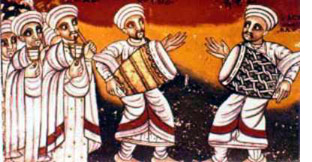
The Ethiopian Re'ese Liqawnt (head professor), Yared,
was born on April 25, 505 A.D. in the city of Aksum. His father was named
Adam and his mother Tauklia. Yared's lineage was from the priesthood of
Aksum. When he was six years old his parents gave Yared to the tutorship
of Yishaq, who was a teacher in Aksum. Under this teacher, Yared completed
the study of the alphabet and began to study the Psalms. However, he had
difficulty learning his lesson and was sent back to his parents by his
teacher. His father having died in the meantime, his mother, Tauklia,
placed him in the hands of her brother, Abba Gedeon, who was the parish
priest, with the request that he should raise and educate Yared. Abba
Gedeon was the teacher of the Old and New Testaments in the courtyard
of the church of St. Mary of Sion and he had begun translating the Holy
Scriptures into Geez from Hebrew and Greek. Yared lodged with Abba Gedeon
and began studying along with the other children but for years he lagged
behind the others in his studies and so was constantly reprimanded and
punished by the new teacher. Yared was not bright student and however
much he studied he could not grasp his lessons. Because of his slow-mindedness
he became an object of derision and mockery to his classmates. One day
his uncle whipped Yared severely, saying: You should not lag behind your
classmates and you should pay attention to your studies as the others
do.
Yared became bitter about his failure as a student and decided to go elsewhere
and start life anew. He therefore fled from the school and while journeying
to his uncle's birth place, Medebai welel, he was caught by a heavy shower
and was obliged to take cover under a tree near a spring called Maikerah,
some four kilometers outside the city of Aksum.
While sheltering under the trees, pondering and feeling remorse about
his failure, he witnessed an event that was to change his whole life.
His attention was caught by a caterpillar struggling time and again despite
repeated failures, to climb up the trunk of tree to eat of its leaves.
Six times the caterpillar failed but on the seventh trial it struggled
with all its might and was able to reach its destination. Watching the
perseverance of the caterpillar, Yared wept, comparing his weakness with
the strength of the grub. After seeing the stamina of the tiny creature,
he decided to return and take up his studies again. He reasoned that man
was a creature superior to a caterpillar and as the caterpillar had, with
repeated effort, reached its goal and eaten of the leaves of the tree
so he too should bear the consequences such as whipping, study diligently
and succeed. Having decided this, he returned to his spiritual teacher,
Abba Gedeon and begged to be forgiven and to be taken back to continue
his studies. Abba Gedeon relented and began teaching him the Psalms. Besides
continuing his studies, Yared went to the church of St. Mary of Sion every
day and prayed to God saying: "Oh ! merciful lord give me wisdom! " God
heard the child's prayer and endowed him with insight and intelligence.
His sudden brightness filled his teacher with wonder. Thus he was able,
through diligence and hard work, to complete the study of the Old and
New Testaments within a short time. Since Yared was now a highly gifted
student, he finished his studies with astounding results and thereafter
became a deacon. From his teacher Abba Gedeon he had learnt Hebrew and
Greek and was fluent in both these languages. In his understanding of
the Holy Scriptures and knowledge of foreign languages he became the equal
of his teacher. Upon the death of his uncle-cum-teacher, even though he
was only fourteen years old, Yared took over the chair and profession
of his tutor and began giving lessons.
In the Book of May II Sinksar (Lives of the Saints) is related the full
story of how Yared created the chant and notation system inspired and
guided by the Holy Spirit. At this time there was no set of rules for
the liturgical chant. In this same book it is written that when Almighty
God wanted to establish sacred chants, as he was desirous of being praised
upon earth, three Angels were sent from Paradise in the form of three
birds to teach Yared heavenly songs in his own language. The birds circling
in the air in front of Yared sang to him sweet and captivating new songs,
while Yared stood there listening, mesmerized by the sweet sound. The
birds began praising him in his language (Geez), saying "Oh ! famed, honored
(Yared) and full of grace! praised be the womb that bore you, praised
be the breasts the breasts that" you sucked. They then carried him off
to heavenly Jerusalem where twenty-four celestial Angels were singing.
St. Yared standing before the seat of the Trinity sand the secret songs
conceived in his heart and revealed to him by the Holy Spirit.
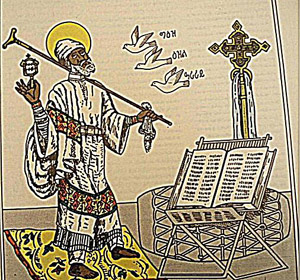 |
Figure 1:
An artist rendering of St Yared while chanting Zema accompanied by sistrum, tau-cross staff. The three main zema chants of Ge'ez, Izil, and Araray which are represented by three birds. Digua, a book of chant, atronse (book holder), a drum, and a processional cross are also seen here. Source: Methafe Diggua Zeqidus Yared. Addis Ababa: Tensae Printing Press, 1996. |
When he was brought back to Aksum, Yared went to the chief
priest of the church of Aksum at nine in the morning and standing in front
of the Holy ark of Sion raised both his hands and sang: "Praised be the
Father, praised be the Son and praised be the Holy Ghost. He first created
Sion and heaven and reveled to Moses the Law of the Old Testament". He
called this song. "Ariam" which means supreme heaven, abode of God.
While Yared was in heaven he had heard the angels praising God with musical
instruments such as the inzira (a large flute), the masinquo (a one-stringed
violin), the tsenatsil (a type of sistrum), the kebero (a large drum),
and the begena (great harp). He thus had these instruments made and used
them to accompany his hymns. St. Yared himself testified that he had indeed
heard his hymns from the angels in heaven saying: "Praised be God, Holy,
Holy, Holy God, Your hallowed Lordship ! Ruler of heaven and earth. How
wondrous is the song I heard from the angels in heaven! "Now Yared set
to work and composed a large number of chants for the hymns and liturgy
of the church. He also invented a system of musical signs and symbols,
and introduced the mequamia (praying stick) to provide support during
the long services of his sacred dance.
The emperor who ruled Ethiopia during this time was Gebre Meskel (525-539
A.D) the son of the renowned Emperor Kaleb. The fact that during his reign
Ethiopia produced her greatest musician and poet, Saint Yared, who as
the creator of Zema (music) and poetry, surpassed all, pleased the Emperor
so much that he was content to conduct the matters of state and leave
to Yared the affairs of the Church. Together they instituted the celebration
of Hosana (Palm Sunday) in the city of Aksum. This custom which they established
is still practiced in churches throughout Ethiopia.
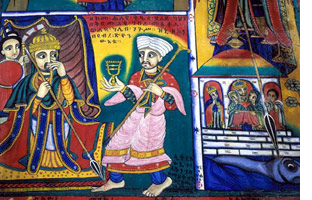
St. Yared was the author of many religious songs and hymns devoted to particular occasions of the seasons and of the months and to the days and festivals of the saints and the Holy Trinity. He divided his hymns into four parts, each with its own melody. These songs were for the four seasons of the years: winter, summer, spring and autumn. He named the great book comprising these church hymns, Deggua. Deggua means in Tigrigna, De'guaa which in turn means lamentations, songs of mourning or higher understanding. The great Degua is also called "Mahlete Yared" meaning treasury of hymns or songs of Yared. He prepared the Deggua in the three modes of chanting used in the church and known respectively as Geez, Ezel and Ararai. Geez means the plain chant for ordinary days; Ezel means a more measured beat for funerals; Ararai means a lighter, free mood for great festivals. The three modes: Geez, Ezel and ararai are supposed to represent the Father, The Son and the Holy ghost respectively.
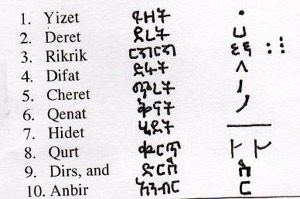 |
Names and signs of St. Yared zema chant.
The names are written in Ge'ez in the second column. The signs are in the third column. |
Yared, after having written the Deguas on parchment,
created ten tones with notation. His innovation was centuries old before
Europeans created the present musical notation with its seven letters
of the alphabet. As noted above, after composing his hymns in the three
modes, he created the following ten notes:
These have and order of arrangement and together are called "Seraye".
The name "Seraye" signifies their being hymnary guides, its veins and
bases. Yared's notation comprises dashes, curves and dots having particular
meanings.
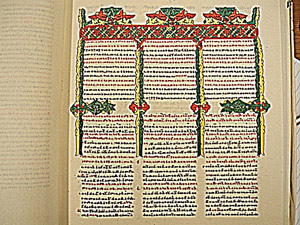 |
Figure 2. An illustrated Zema chant text and notes from the Book of Digua (Metshafe Digua Zeqidus Yared), p. 3. |
Tseome Dugua which is part of the Degua is written about
fasting. Therefore it is sung only during Lent. Hence its named Tsome
Dugua (Songs for Lent)
Me'eraf is sung on Sabbath vigils, for prayer, praising the Lord or when
hymns are performed.
Zimare is sung after communion in honor of the Holy Communion.
Mewasit is for funeral services, requiems and for Easter Eve.
Quidase is performed during communion.
All these are chanted in the three modes of Geez, Ezel and Ararai and
non of St. Yared's compositions departs from these three modes. To prepare
the above mentioned book (that is the Deguaa, Tsome Deguaa, Meraf, Zamare
and Mewasit) together. St. Yared laboured for nine years.
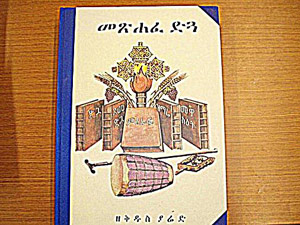 |
Figure 3.
The front cover of Metshafe Digua Zeqidus Yared (Book of Digua). The cover shows the five volumes of Yared's Zema composition: Digua, Tsome Digua, Miraf, Zimare, and Mewasit. Processional Ethiopian cross, drum, sistrum, and tau-cross staff are also illustrated in the cover. |
Many authorities consider Yared not only the father of
hymns but also the first to introduce poetry, the signs of Degua and the
first to write musical notes and use musical instruments to accompany
his hymns.
Dr. Sergew Hable Selassie in his book, Ancient and Medieval Ethiopian
History up to 1270, writing about the works of Yared notes, "Although
it (the Deguaa) was presented in the general form of poetry, there are
passages relating to theology, as well as to philosophy, history and ethics."
Yared's compositions bear witness to his being a composer of music, a
writer and a poet of the highest talent.
All the hymns composed by Yared continue to be sung in churches all over
Ethiopia by priests and choirs of debteras. These hymns are accompanied
by various musical instruments created by Yared giving the performance
more fullness. The singers chant in a choir in harmony with the melody,
slowly moving their prayer sticks back and forth or up and down in an
orchestrated movement known as tirkeza. The beating of the drums and the
rattling of the sistra also join in to make the music more melodious.
As Edward Ullendorff states in his book The Ethiopians: "The entire spectacle,
the carrying of the Tabot (Ark of the Convenant) in solemn procession,
accompanied by singing dancing, beating of staffs or prayer sticks, rattling
of sistra and the sounding of drums, has caused all who have witnessed
it to feel transported."
Before the time of Yared's innovation, the church did not use poetry and
song and the priests were not accustomed to performing spiritual chants.
They prayed in whispers, mumbling and repeating the sentences. Therefore,
when Yared first poured forth his sweet melodies, the emperor, the queen,
the courtiers, and the people hastened to where he was and, enraptured
by his voice, stood there listening the whole day long.
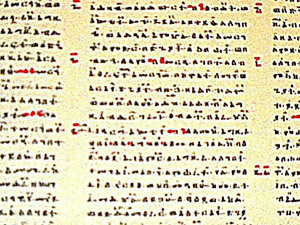 |
Figure 4.
A sample page from St Yared's zema or chant composition from Metsafe Digua Zeqidus Yared. |
The Nine Saints who had fled from religious persecution
in the Byzntine Empire and who had come to Ethiopia in the 5th century
had good spiritual relations with Saint Yared and he occasionally visited
them at their individual churches which were built for them by the Aksumite
Emperors. It was Saint Yared who taught these saints hymns and the hymns
he taught them are to be found in the Deguaa. One of the churches consecrated
by Yared is Debre Damo founded by Abune Aregawi, one of the Nine saints.
When saint Yared saw this church he was overwhelmed by its magnificence
and sang sweet and captivating hymns and stayed there teaching hymns for
many days with Abune Aregawe before returning to Aksum.
Saint Yared, beside composing many spiritual songs and hymns of his own,
also invented, a special type of musical notation for the guidance of
singers and dancers.
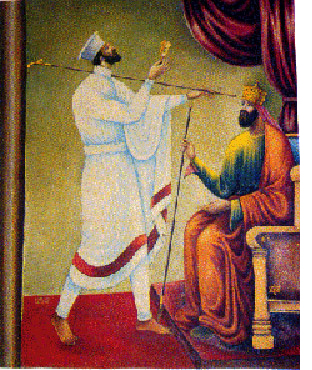
Yared was blessed with a sweet voice and anyone who
heard him sing could no but help being captivated. One day while Yared
was performing his spiritual songs in the church of Aksum Sion, the emperor
enchanted by the songs left his place and came towards Yared. Standing
there and gazing into the eyes of Yared, the Emperor leaned upon his spear
which had a sharp point and thus unwittingly pierced the foot of Yared.
Yared, too, was so carried away by his own singing that he was not aware
of the pain and it was only when he reached the end of his song that the
king pulled out the spear and blood gushed forth from Yared's foot. When
the Emperor saw what had happened he was deeply shocked and asked Yared
to demand of him whatever compensation he wanted even if it were half
of him whatever compensation he wanted even if it were half of his empire.
The sage replied: "Promise to grant me what I wish" and the emperor swore
in the name of God to do so.
Yared then said:" allow me to retire from my work in the court and to
live among the people so that I may devote the rest of my life to teaching,
to meditation and to prayer." When the emperor heard this he wailed and
lamented, saying "You filled my heart with joy by transforming the church
into a semblance of the seat of God and the priests into the likeness
of the angels of God but now you have wrought grief upon me." "However,
Yared's wish was fulfilled and as Yared left the court and the city of
Aksume grieved because of his departure.
This great teacher, apart from composing hymns, went from place to place
imparting his knowledge to the uninitiated. One such place that was fortunate
enough to receive his teaching was the Church of St. Qirqos on the Island
of Lake Tana. While staying for two years in this church, St. Yared mixed
writing ink in a stone bowl and wrote his Deguaa. The deguaa written by
his own hand, the bowl in which he is said to have mixed ink, his sistrum
and prayer stick are preserved to this day in this church. Tradition holds
that this church was built by Emperor Gebare Meskel, Abune Aregawe and
St. Yared when they came to visit Lake Tana and the island.
St. Yared also stayed at the church of St. Mary which Abune Aregawi build
upon Zur Amba mountain in Gayint District. This church was built at the
order of Emperor Gebre Meskel. Here St. Yared taught the Mewasit canticle,
for some three years. This place is known even today as a center for learning
hymns and Mewasit and the debteras have to undergo long and arduous training
to qualify for that post.
From here St. Yared went to Tselemt sub-district in the freezing and icy-cold
conditions of the Semien mountains to meditate and to teach people who
came from near and far. He also went from place to place teaching in Wegera
and Agew, living a life of fasting and prayer, serving and praising God
with his hymns.
His disciples taught the hymns and educational system of Yared in the
monasteries and churches and to this day the works of St. Yared still
remain the corner-stone of Ethiopian ecclesiastical culture. In recognition
of his religious and spiritual work he was canonized as the greatest Saint
of the Ethiopian Church.
St. Yared was not only a composer of hymns but also the originator of
a new system of education, revealing his discoveries to the people in
Geez which they could easily understand therefore, he is the father of
Ethiopian education and has greatly contributed to Ethiopian culture.
As can steel be seen today, ecclesiastical music and poetry comprise a
major part of traditional Ethiopian education and the bases of these were
laid down by Yared. The primary stage, 1st nebab bet (simple reading),
the 2nd comprising Zeima Bet (school of music or hymns), the 3rd Quine
Bet (poetry), the 4th Mesahft Bet (Study of the interpretation of the
Scriptures) is still given in the curriculum of the Church schools. The
Church was the main source of cultural and ethical inspiration through
the years of Ethiopia's isolation and the generations that followed.
On the celebration of emperor Gebre Meskel's coronation day, singing for
the first time the song called "Teketsel Tsigie Gebre Meskel Hatsegue,"
St. Yared placed a wreath of flowers upon the Emperor's crown. This episode
is found, written in the Duguaa. Of those musical instruments traditionally
used in the performance of religious songs, following the composition
set by St. Yared, the Masinquo, Kebero and Inbilta are played accompanying
secular songs. Thust, St. Yared, with his versatile and inventive turn
of mind, contributed much to the birth and development of secular music.
The work of St. Yared gave Ethiopia the gift of music from the 6th century
onwards. However, because of Ethiopia's hundreds of years of isolation
from the outside world, due acclaim has not been given to St. Yared as
a great contributor to the system of modern music and poetry as given
to those such as Hayden Bach and Mozart who emerged over a thousand years
after him in Europe. However, in his own country he is recognized as a
musical genius and the patron saint of many churches in Addis Ababa, Mekelle,
RasDashen, etc. The music school in Addis Ababa has been named after St.
Yared and a religious school in the city of Aksum also bears his name.
St. Yared died at the age of 66 on May 20, 571 A.D. in a cave below the
Semien mountain where he had been accustomed to teach.
The history of Saint Yared is found in the book written about his life
called Dirsane Gedl Ze Quidus Yared (Story of the struggle of St. Yared),
in many religious books and in the Kibre Negest (Glory of the Kings).
All these books praise the superb quality of the chants of St. Yared.
There is hardly any other person about whom so much has been written in
Ethiopia as St. Yared.
One sage captivated by Yared's song wrote,
"O, Yared, Priest of the altar on high in the heavenly places;
Whither the glorious hand of the Father of all has led thee'
Lead thou me also with thee that we may chant together"
Another writer pays tribute saying: "He (Yared) composed chants the like
of which can be found neither among the Greeks, Romans, Egyptians and
Syrians nor in the east or west."
'None has so far discovered a new mode of music which can be added to
the three modes of Saint Yared." says another.